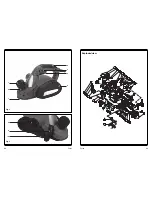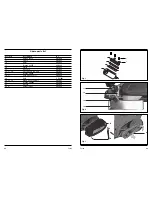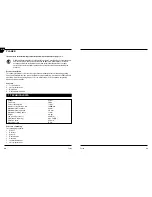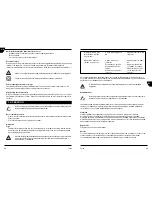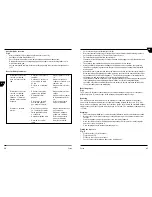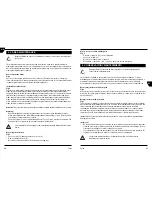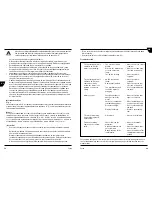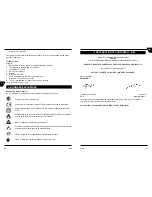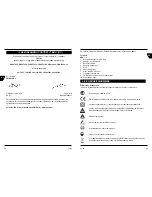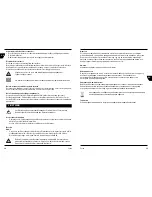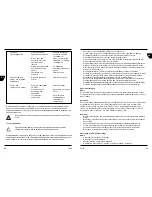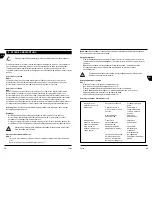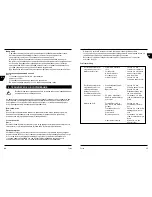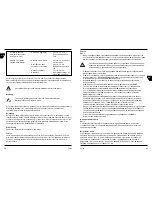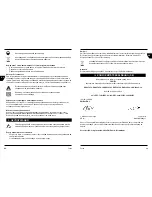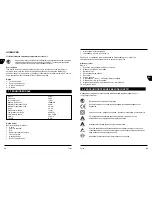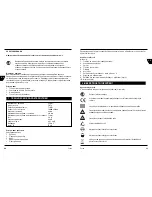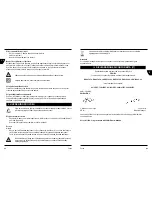
Ferax
07
•
Secure the work piece with clamps or similar.
•
Place the front sole on the edge of the work piece in such a way that the planing tool does
not yet touch the work piece. The work piece must be level.
•
This machine is equipped with a safety switch.
•
Start the machine by pressing the “lock off” button (to disengage the switch) and switch on
the machine.
•
The planer is now switched on and you can let go of the release button.
•
Always hold the planer with both hands on the handles, so as to gain the best possible
control over your planing operations. Besides you do not risk becoming in touch with the
moving parts.
•
When the machine has reached full speed it can be pushed to the front over the work piece.
At the beginning of the planing operation, put some pressure on the front and at the end of
the operation, on the rear of the appliance. This results in the appliance remaining flat on
the work piece and prevents the corners from getting rounded off.
•
To obtain a level and smooth surface use a greater planing depth when rough planing and a
lesser planing depth when planing a layer. Hold the electric tool straight during the
operation, otherwise you will obtain an uneven surface. After the operation switch off the
electric tool and remove the mains plug.
Bevelling edges
Fig. 1
The V-groove in the planer shoe allows easy beveling of workpiece edges. Place the planer
with the V-groove (7) onto the edge of the workpiece and guide along the edge.
Rebating
The rebating depth stop can be used by planing for example a window- or doorpost.
Loosen the locking nut and adjust the required rebating depth with the scale (Fig. 2, 9).
Carry out the the planing procedure several times (guide the planer with sideward suppor-
ting pressure), until the required rebating depth is reached. The maximum rebating depth
is 11 mm.
Warning!
•
Take care that your hand never comes in contact with the work piece during the operation.
•
Only use the electric plane on the upper side of the work piece, never from below or from
the side.
•
Store the appliance only after it has come to a complete standstill.
•
Use a suction device to suck off wood shavings or dust. For this use the connecting pipe
and connect a suction pipe to it.
•
Use a holding device to work on small work pieces.
Fitting the rip fence
Fig. 4
•
Fit the bracket (12) to the planer
•
Tighten knob (11)
•
Fit the rip fence on to the bracket
•
Set the correct cut width and tighten the butterfly nut
GB
58
Ferax
Sustitución de la correa
Fig. 5
•
Afloje el tornillo (15) y extraiga la cubierta de la correa (16).
•
Sustituya la correa desgastada (17).
•
Antes de instalar la nueva correa, limpie cuidadosamente ambas poleas.
•
Coloque la correa nueva en la polea pequeña y después insértela en la grande con la
mano mientras la gira.
•
Vuelva a colocar la cubierta de la correa (16) y apriétela con el tornillo correspondiente
(15).
Resolución de problemas
•
El interruptor de servi-
cio está encendido,
pero el motor no mar-
cha.
•
El interruptor de servi-
cio está encendido,
pero se oyen ruidos
extraños, el motor no
marcha o marcha muy
despacio.
•
El motor se calienta
mucho.
•
Circuito eléctrico inter-
rumpido.
•
Conexiones sueltas en
el enchufe o la toma
de red.
•
Defecto en el interrup-
tor.
•
El contacto del inter-
ruptor se ha fundido.
•
Componente blo-
queado.
•
Potencia de empuje
demasiado grande,
que quema el motor.
•
Hay cuerpos extraños
en el interior del motor.
•
Falta grasa lubricante
o está sucia.
•
Carga demasiado alta.
•
Cuchilla de cepillar
roma.
•
Haga reparar el circui-
to.
•
Haga comprobar o
reparar el enchufe y la
toma de red.
•
Haga sustituir el inter-
ruptor.
•
Haga sustituir el inter-
ruptor.
•
Haga probar o reparar
la herramienta eléctri-
ca.
•
Utilice una potencia
menor al trabajar.
•
Haga eliminar los cuer-
pos extraños.
•
Haga que apliquen
grasa o la cambien.
•
Utilice una potencia
menor al trabajar.
•
Cambie la cuchilla.
ES


